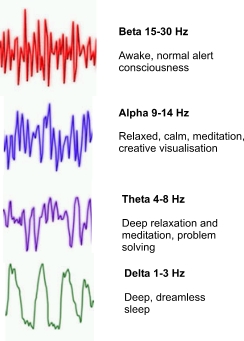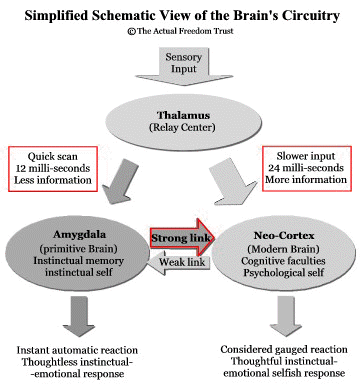Jhanas and brain waves - Discussion
Jhanas and brain waves

Pål S, modified 13 Years ago at 9/9/10 8:25 AM
Created 13 Years ago at 9/9/10 8:25 AM
Jhanas and brain waves
Posts: 196 Join Date: 8/16/10 Recent Posts
I wonder if there is a correlation between the different jhana stages and the brain wave stages.

First problem: There seems to be varying interpretations of what the different brain wave stages "feels like".
Second problem: What little information I have found on jhana compared to brain waves appears to be based mostly on, well, bullshit.
I'm surprised that I can't find any scientific studies on the subject (maybe I'm not looking hard enough). Wouldn't it be nice to have scientific "proof" of the different jhanas; that the jhanas can be linked to specific brain wave frequencies. It probably isn't that straight-forward but anyway it would be interesting to see "the brain on jhana".
The main reason I ask is that while I'm new to the jhana models I'm more familiar with brain waves. I can recognize when my mind switches to an Alpha state for example, so if I knew that this correlates to say access concentration it would help a lot.

First problem: There seems to be varying interpretations of what the different brain wave stages "feels like".
Second problem: What little information I have found on jhana compared to brain waves appears to be based mostly on, well, bullshit.
I'm surprised that I can't find any scientific studies on the subject (maybe I'm not looking hard enough). Wouldn't it be nice to have scientific "proof" of the different jhanas; that the jhanas can be linked to specific brain wave frequencies. It probably isn't that straight-forward but anyway it would be interesting to see "the brain on jhana".
The main reason I ask is that while I'm new to the jhana models I'm more familiar with brain waves. I can recognize when my mind switches to an Alpha state for example, so if I knew that this correlates to say access concentration it would help a lot.

tarin greco, modified 13 Years ago at 9/9/10 12:12 PM
Created 13 Years ago at 9/9/10 12:12 PM
RE: Jhanas and brain waves
Posts: 658 Join Date: 5/14/09 Recent Posts
Ian And, modified 13 Years ago at 9/9/10 12:36 PM
Created 13 Years ago at 9/9/10 12:14 PM
RE: Jhanas and brain waves
Posts: 785 Join Date: 8/22/09 Recent PostsP O V:
I'm surprised that I can't find any scientific studies on the subject (maybe I'm not looking hard enough). Wouldn't it be nice to have scientific "proof" of the different jhanas; that the jhanas can be linked to specific brain wave frequencies. It probably isn't that straight-forward but anyway it would be interesting to see "the brain on jhana".
You're right. It isn't that straightforward.
P O V:
The main reason I ask is that while I'm new to the jhana models I'm more familiar with brain waves. I can recognize when my mind switches to an Alpha state for example, so if I knew that this correlates to say access concentration it would help a lot.
So, what you're basically saying here is that you are searching for a way to be able to identify absorption states when they are occurring in your practice. That's always the first stumbling block that new practitioners have when attempting to practice the jhanas.
I was around when some of the first literature was being published in the 1960s about brain waves and the alpha state, so I am familiar with this.
The only problem with using brain waves to be able to identify these states is that they do not always line up with the way the Buddha has described, and so many of us have experienced, these states. For instance, the alpha state can veer off into dull mindedness, which is the polar opposite of mindful absorption. I've just given you a couple of hints right there.
If you're looking for a way to identify absorption when it occurs in your practice, you would do better to work using the model of samadhi and how this can expand into full blown absorption. After all, the eighth step of the noble eightfold path is "right concentration" or samma samadhi. And before "right concentration" can take place, "right mindfulness" (samma sati) must be established in place. Now, the term samadhi is used in a variety of ways in the Pali suttas. But, as it pertains to absorption and the jhanas, there are some very specific factors involved, and these would include the development of concentration such that the "unification of the mind" on an object or subject takes place. As that unification becomes absorbed in that object or subject, one reaches the first jhana. So, the first step on the way to absorption is the cultivation and development of "concentration" (which also happens to be one of the definitions of samadhi). From there, together with mindful alertness (sati), the mind becomes unified around the object, which in turn establishes the first jhana.
One thing to keep in mind here is that this process (the process of achieving jhana or absorption) is not mystical or mysterious (an altered state). It is straightforwardly involved with the cultivation of enough concentration to allow the mind to become unified and absorbed in its target, be that an object or a subject.
So you see, attempting to equate the alpha state with the description given above is problematic, as it simply does not adequately begin to encompass all the factors involved in the achievement of absorption. It doesn't even address any of the factors involved in achieving so-called "access concentration," for the same reasons as given above (i.e. the mind can devolve into dull mindedness and therefore veer off the path of concentration necessary to achieve "access concentration").
I'll give you a rule of thumb to go by as far as the achievement of "access concentration" is concerned. It involves unbroken and undistracted awareness of an object for an extended period of time. For example, if you can maintain unbroken awareness or with broken awareness not passing by without notice of an object (like the breath, for instance) for a period of two minutes then you have the requisite amount of concentration necessary to attempt to enter the first jhana.

Jeffrey S, modified 13 Years ago at 9/9/10 5:30 PM
Created 13 Years ago at 9/9/10 5:27 PM
RE: Jhanas and brain waves
Posts: 21 Join Date: 6/28/10 Recent Posts
What I find interesting is this image I found on the Actual Freedom site:

Notice the rate of information input for the inner-brain and neo-cortex? Its either 12 milliseconds or 24 milliseconds, which might correlate with the vibration frequencies found in different nanas or jhanas.
During the A&P the frequencies are fast and attention is in the center. According to the diagram above, the amyglada has a fast reception rate and is located in the center of the brain.
Likewise in dark night territory vibrations are longer and harsher and attention is on the periphery. The neo-cortex also has a slower information frequency and is located on the outer edge of the brain.
Equanimity, which has balanced attention on both center and periphery, could just easily be when the center of the brain and the neo-cortex are in balance with each other, thus providing a panoramic attention.
The implications of this are huge. This would be evidence for how insight meditation is healthy for the brain. We could even possibly figure out exactly what stream entry really is! Insight wouldn't be a matter of left/right brained functioning but center/peripheral brained functioning!

Notice the rate of information input for the inner-brain and neo-cortex? Its either 12 milliseconds or 24 milliseconds, which might correlate with the vibration frequencies found in different nanas or jhanas.
During the A&P the frequencies are fast and attention is in the center. According to the diagram above, the amyglada has a fast reception rate and is located in the center of the brain.
Likewise in dark night territory vibrations are longer and harsher and attention is on the periphery. The neo-cortex also has a slower information frequency and is located on the outer edge of the brain.
Equanimity, which has balanced attention on both center and periphery, could just easily be when the center of the brain and the neo-cortex are in balance with each other, thus providing a panoramic attention.
The implications of this are huge. This would be evidence for how insight meditation is healthy for the brain. We could even possibly figure out exactly what stream entry really is! Insight wouldn't be a matter of left/right brained functioning but center/peripheral brained functioning!

Eran G, modified 13 Years ago at 9/10/10 2:32 AM
Created 13 Years ago at 9/10/10 2:32 AM
RE: Jhanas and brain waves
Posts: 182 Join Date: 1/5/10 Recent Posts
Check out some of the NeuroDharma stuff by Rick Hanson: http://www.rickhanson.net/media/talks/neurodharma
He also has a buddhist geeks interview where he specifically talks about jhanas and the brain.
He also has a buddhist geeks interview where he specifically talks about jhanas and the brain.
J Adam G, modified 13 Years ago at 9/13/10 3:44 PM
Created 13 Years ago at 9/13/10 3:44 PM
RE: Jhanas and brain waves
Posts: 286 Join Date: 9/15/09 Recent Posts
As a psychology/neuroscience student, I find that diagram very problematic. It would be one thing if it were merely oversimplified, but some of it is just plain wrong. A more accurate version of what it says is this:
Sensory data is processed in many ways across the whole brain. Conscious perception generally starts at the thalamus, which does act like somewhat of a relay station for sense inputs. Having arrived at the thalamus, the data is routed to the cortex. You can pretty much assume that if something is conscious, the cortex is involved. (Though the opposite idea, "everything the cortex does is conscious," is NOT true.)
Emotional reactions to stuff can sometimes be triggered by "less-conscious" processing done when the sensory data reaches what's called the "limbic system." That sensory data might have been sent from the thalamus straight to the limbic system, or it might have first been processed by the cortex before it reaches the limbic system. The limbic system is involved with everything you do -- emotion, memory, assessment, decisions, behavior... The limbic system and the cortex have MANY connections between them, going both ways.
Oh, and I'm sorry, but throw away the 12ms and the 24ms values. They're sort of meaningless. Maybe they would be useful if we knew what they were actually measuring... But if you're looking for the source of vipassana vibrations, it's probably not going to be in the length of time that it takes data to reach the amygdala from the thalamus.
Now, as for jhana, we see increased decreased theta in the prefrontal areas. There was increased beta, high alpha, and greatly increased gamma in the prefrontal areas. So, really we see more prefrontal activity, not less. There was also more theta and less high alpha in what I assume is the parietal cortex, so that's decreased activity. That finding makes sense given that bodily sensations seem to fade away in jhana. The parietal cortex contains the areas responsible for processing touch sensations.
There was decreased gamma in an area I can't totally identify -- I guess it's motor or premotor area? I don't know of any gamma motor rhythms, so I don't know what that's about. An alternative idea is that it's the cingulate cortex which is supposed to regulate attention and mammalian emotions, but I don't know how good a scalp EEG would be at measuring cingulate cortex activity. At any rate, there's clearly some gamma rhythm near the motor areas that's going away in jhana.
SO, the takeaway from all this brain research is... err, well, there isn't really a takeaway for meditators. =(
I mean, if you have access to prefrontal stimulants like Ritalin or Adderall, they're expected to help with jhana. In fact, I can assure you that they do, based on personal experience. But other stimulants like Provigil or caffeine probably won't help much unless you're sleepy.
And there's basically no takeaway in terms of modifying the meditation instructions. It'll be a while before brain research can tell meditation teachers and students anything they don't already know. I bought "Buddha's Brain" because it was supposed to give neuropsychology-based instructions to improve meditation. The suggestions were great, but they basically consisted of "Advice meditators already know, plus a brain-based explanation of how the advice helps."
Sensory data is processed in many ways across the whole brain. Conscious perception generally starts at the thalamus, which does act like somewhat of a relay station for sense inputs. Having arrived at the thalamus, the data is routed to the cortex. You can pretty much assume that if something is conscious, the cortex is involved. (Though the opposite idea, "everything the cortex does is conscious," is NOT true.)
Emotional reactions to stuff can sometimes be triggered by "less-conscious" processing done when the sensory data reaches what's called the "limbic system." That sensory data might have been sent from the thalamus straight to the limbic system, or it might have first been processed by the cortex before it reaches the limbic system. The limbic system is involved with everything you do -- emotion, memory, assessment, decisions, behavior... The limbic system and the cortex have MANY connections between them, going both ways.
Oh, and I'm sorry, but throw away the 12ms and the 24ms values. They're sort of meaningless. Maybe they would be useful if we knew what they were actually measuring... But if you're looking for the source of vipassana vibrations, it's probably not going to be in the length of time that it takes data to reach the amygdala from the thalamus.
Now, as for jhana, we see increased decreased theta in the prefrontal areas. There was increased beta, high alpha, and greatly increased gamma in the prefrontal areas. So, really we see more prefrontal activity, not less. There was also more theta and less high alpha in what I assume is the parietal cortex, so that's decreased activity. That finding makes sense given that bodily sensations seem to fade away in jhana. The parietal cortex contains the areas responsible for processing touch sensations.
There was decreased gamma in an area I can't totally identify -- I guess it's motor or premotor area? I don't know of any gamma motor rhythms, so I don't know what that's about. An alternative idea is that it's the cingulate cortex which is supposed to regulate attention and mammalian emotions, but I don't know how good a scalp EEG would be at measuring cingulate cortex activity. At any rate, there's clearly some gamma rhythm near the motor areas that's going away in jhana.
SO, the takeaway from all this brain research is... err, well, there isn't really a takeaway for meditators. =(
I mean, if you have access to prefrontal stimulants like Ritalin or Adderall, they're expected to help with jhana. In fact, I can assure you that they do, based on personal experience. But other stimulants like Provigil or caffeine probably won't help much unless you're sleepy.
And there's basically no takeaway in terms of modifying the meditation instructions. It'll be a while before brain research can tell meditation teachers and students anything they don't already know. I bought "Buddha's Brain" because it was supposed to give neuropsychology-based instructions to improve meditation. The suggestions were great, but they basically consisted of "Advice meditators already know, plus a brain-based explanation of how the advice helps."

Eric G, modified 12 Years ago at 6/17/11 9:27 AM
Created 12 Years ago at 6/17/11 9:27 AM
RE: Jhanas and brain waves
Posts: 133 Join Date: 5/6/10 Recent Posts
Villum (redacted), modified 12 Years ago at 6/18/11 11:28 AM
Created 12 Years ago at 6/18/11 11:28 AM
RE: Jhanas and brain waves
Posts: 60 Join Date: 3/24/11 Recent PostsJ Adam G:
SO, the takeaway from all this brain research is... err, well, there isn't really a takeaway for meditators. =(
I mean, if you have access to prefrontal stimulants like Ritalin or Adderall, they're expected to help with jhana. In fact, I can assure you that they do, based on personal experience. But other stimulants like Provigil or caffeine probably won't help much unless you're sleepy.
I mean, if you have access to prefrontal stimulants like Ritalin or Adderall, they're expected to help with jhana. In fact, I can assure you that they do, based on personal experience. But other stimulants like Provigil or caffeine probably won't help much unless you're sleepy.
This fits with my personal experience with (legally prescribed) dexamphetamine (ie. Dexedrine). Nice to see some confirmation of what i seemed to be the case from my personal experience.
T Dan S-, modified 10 Years ago at 3/14/14 12:21 AM
Created 10 Years ago at 3/14/14 12:21 AM
RE: Jhanas and brain waves
Posts: 69 Join Date: 5/3/11 Recent Posts
sawfoot _, modified 10 Years ago at 3/14/14 3:23 AM
Created 10 Years ago at 3/14/14 3:21 AM
RE: Jhanas and brain waves
Posts: 507 Join Date: 3/11/13 Recent Posts
The working paper involving Brasington has been written up and published:
http://downloads.hindawi.com/journals/np/2013/653572.pdf
Hagerty, M. R., Isaacs, J., Brasington, L., Shupe, L., Fetz, E. E., & Cramer, S. C. (2013). Case study of ecstatic meditation: fMRI and EEG evidence of self-stimulating a reward system. Neural plasticity, 2013.
I don't know of anything else really. What Rick Hanson says Jhanas makes sense, but is very speculative and there isn't much evidence to back it up.
http://downloads.hindawi.com/journals/np/2013/653572.pdf
Hagerty, M. R., Isaacs, J., Brasington, L., Shupe, L., Fetz, E. E., & Cramer, S. C. (2013). Case study of ecstatic meditation: fMRI and EEG evidence of self-stimulating a reward system. Neural plasticity, 2013.
I don't know of anything else really. What Rick Hanson says Jhanas makes sense, but is very speculative and there isn't much evidence to back it up.





